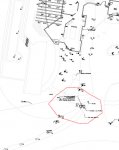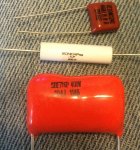Putting it together
Putting it together
140312-2147 EDT
I am quite sure the tested motion sensor uses a contact type relay to control its output. One test for this is the voltage drop across the sensor with a 75 W lamp load, 0.025 V, and also one can hear the relay click.
From the line to neutral while the sensor is active with the load attached?
140312-2147 EDT
For your capacitor experiment connect a couple pigtail leads to the white capacitor marked 0.1 ufd, 400 V. Put tape or heat shrink over the exposed areas. Run the experiment.
Why the white one? Why are those monster ones just that, monsters? Why not either of the orange ones?
140312-2147 EDT
If successful, then solder your pigtails moderately close to the capacitor, find a small plastic container to contain the capacitor, and high enough that when filled with the capacitor and epoxy that everything is fully encapsulated. I would try Devcon 7814331345 which is clear and has an extended work time. I have never created a large casting with this epoxy, but it should be ok. If you had an insulating filler it would require much less epoxy.
Uh oh, this is not getting done today, we are making connections. I was planning on inserting the pins of the pins of the capacitor into the female spade terminal with some #14 or #16 wire... I know the breaker is 20 amps and that I should introduce fused protection.... Why do you encapsulate the capacitor? Is that what both of the orange ones already are?
140312-2147 EDT
This is still experimental. If it totally solves the problem, then you have to determine what to do about any sort of listing, or approval.
To be honest, this is probably not taking place
140312-2147 EDT
Totally how many capacitors did you buy?
50 of the monsters, maybe 7-10 of the white (they are outside in the van, we are all leaving in a few minutes for the site), maybe 7-10 of the little orange ones.. I am sorta laughing while typing this because I am sure you are calling them by their technical makeup/name whereas I am using color and relative sizes. If the white ones work, I will keep them, glad to send you all the others.
Side note: I was working with a friend on a solar project yesterday and he complained about some sensors (RAB) that were hit or miss with functionality on his own home. I asked him what model, he did not know. I asked him about the load, it is some LED retrofit lamps. All I said was "you need to check that the sensor is rated for the load". You can see how "electricians" like me, we tend to just grab some things and connect them. Also, even when some may take the time to match components to their load, clients change loads down the road.
Last: The relays I have seen, whether clicking or not, have a neutral and a common line voltage. So, in the case of connecting directly to a load, like a transformer, doesn't the coil of the relay become subjected to some potential damage?
Last Last: I will post what happens later today.



